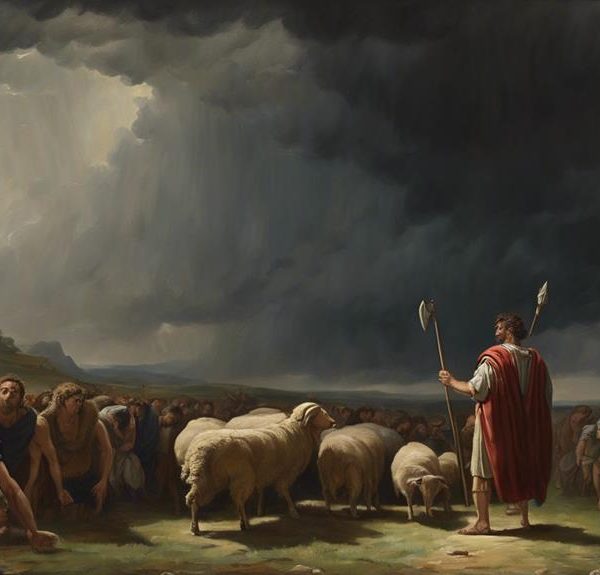Yearning to understand biblical symbolism? Delve into the diverse 'Types of Vessels in the Bible' and their spiritual significance.

Types of Vessels in the Bible
You may not realize that the Bible, both Old and New Testaments, makes frequent reference to 'vessels'. These are not simply physical containers like jars or pots, but are often imbued with symbolic significance, reflecting spiritual and cultural realities of the times.
From the golden vessels in the Solomon's Temple to the clay vessels in Jeremiah's prophecies, the biblical narrative is rich with these metaphoric tools. Intrigued? There's much more to explore about the role and representation of these vessels in biblical texts.
Key Takeaways
- Biblical vessels serve as powerful metaphors for faith, service, and divine purpose, embodying spiritual truths.
- In Old Testament narratives, vessels play significant roles in worship and symbolize divine commands and covenants.
- New Testament vessels convey deeper spiritual significances and are frequently used as symbols of faith, purity, and preparedness.
- The spiritual metaphor of vessels depicts humans as receptacles of divine will, emphasizing personal holiness, humility, and spiritual readiness.
Symbolism of Biblical Vessels

Diving into the rich tapestry of symbolism, you'll find that vessels in the Bible often embody profound spiritual truths, serving as powerful metaphors for faith, service, and divine purpose. These vessels, often represented as Biblical Ceramics, play a pivotal role in highlighting divine messages and spiritual teachings.
From an analytical perspective, Vessel Interpretations are fascinating. You'll notice that the Bible uses ceramics not just as physical objects, but as symbols of spiritual receptivity and transformation. For instance, clay vessels represent humans, molded by God's hands into unique shapes for His divine purpose. This symbolism underscores the idea that humans, like vessels, can be filled with God's spirit, signifying their readiness to serve.
In addition, the fragility of these ceramics reflects our vulnerability to sin and the need for God's healing and restoration. A broken vessel isn't discarded but mended, symbolizing God's redeeming love and forgiveness.
You'll also come across references to golden vessels, symbolizing purity and divine glory. These vessels, used in sacred rituals, remind us of our call to live holy lives, set apart for God's service.
Understanding these symbolic interpretations, you'll gain a deeper appreciation for the spiritual lessons embedded in Biblical narratives.
Vessels in Old Testament Narratives

Delving into the Old Testament, you'll encounter numerous narratives featuring vessels, each offering a unique perspective on their spiritual and practical significance in ancient times. You'll find the Tabernacle Utensils, which had a profound role in the worship practices of the Israelites. Detailed in Exodus, the Tabernacle housed a variety of vessels, from the Ark of the Covenant to the golden lampstand, each meticulously crafted and imbued with sacred symbolism.
The Ark's construction, in particular, is an intriguing study. Built from acacia wood and overlaid with pure gold, the Ark was a divine vessel. This intricate craftsmanship signaled its role as the dwelling place of God's presence among His people. Yet, it wasn't just a receptacle for the stone tablets of the law. It magnified the sanctity of divine-human communion, encapsulating the covenant between God and His chosen people.
In these narratives, vessels aren't mere objects. They're integral to the plots, symbolizing God's presence, His commands, and His covenant. They reflect the intertwining of the spiritual and the tangible, the divine and the human, in the fabric of Old Testament narratives.
The Significance of Vessels in New Testament

Transitioning to the New Testament, you'll notice a marked evolution in the representation and role of vessels in the biblical narrative. These New Testament Vessel References often carry deeper, spiritual significances. You'll see vessels employed as metaphors for the human body or soul, used to express profound theological concepts.
Delving into the Vessel Parables Interpretation, you'll find that vessels can be seen as symbols of faith, purity, or spiritual readiness. Take the parable of the wise and foolish virgins from Matthew 25, for example. Here, the oil lamps, or vessels, represent preparedness for the return of Christ. Those with filled lamps were granted entrance into the wedding feast, indicating spiritual readiness.
In 2 Corinthians 4:7, Paul described humans as 'earthen vessels' containing the treasure of the gospel. This metaphor underscores the idea that though we may be fragile and imperfect, we hold immense spiritual value.
Moreover, the use of vessels in the Last Supper established a powerful, enduring symbol of Christ's sacrifice. The cup, a vessel, held the wine, signifying Christ's blood shed for humanity's redemption.
These instances underscore the significant evolution of vessels' role and symbolism in the New Testament.
Iconography of Vessels in Christian Art

Building on this biblical symbolism, you'll find that vessels hold a prominent place in Christian art, serving as profound visual metaphors that echo these scriptural themes.
Let's delve into a brief analysis of 'Vessel Depictions in Byzantine Art' and the 'Impact of Vessels on Christian Sculptures'.
Era |
Vessel Depictions |
Impact |
|---|---|---|
Byzantine |
Elaborate, symbolic |
Amplified religious themes |
Early Christian |
Simple, utilitarian |
Established visual symbolism |
Renaissance |
Detailed, realistic |
Enhanced depth, realism |
Baroque |
Dramatic, bold |
Emphasized divine power |
Modern |
Abstract, interpretive |
Provoked thought, introspection |
In Byzantine art, vessels were intricately designed, often incorporated into sacred narratives, thus amplifying the religious themes. Early Christian art, however, kept it simple and utilitarian, serving as a cornerstone for establishing the visual symbolism of vessels. Come the Renaissance, artists began to depict vessels with remarkable detail and realism, enhancing the depth and perception of their sculptures. In the Baroque period, vessels took a dramatic, bold turn, emphasizing the divine power and glory. Modern Christian art has seen more abstract and interpretive depictions, provoking thought and introspection.
As you can see, the portrayal and impact of vessels in Christian art have evolved significantly, always echoing biblical themes.
Understanding the Spiritual Metaphor of Vessels

To fully grasp the spiritual metaphor of vessels, it's crucial to examine their biblical representations and the theological significance they carry. In scripture, vessels are often used as metaphors to depict human beings. You're likened to a container designed to hold, carry, and pour out. This Vessel Metaphor Interpretation speaks to your intended function as a conduit of divine will.
The Spiritual Vessel Application is a call to personal holiness, humility, and receptivity. You're encouraged to be like a clean, ready vessel, prepared for every good work (2 Timothy 2:21). The metaphor speaks to your potential for sanctification and divine service. Just as earthly vessels are utilized according to their cleanliness and readiness, so are you in the spiritual realm.
In essence, understanding the vessel metaphor is a journey of self-discovery and spiritual awakening. It offers insight into your purpose and potential. It challenges you to rise above your physical limitations and embrace your spiritual calling. It's a potent reminder that you're not simply a finite, physical entity, but a spiritual vessel filled with infinite possibilities.
Frequently Asked Questions
How Are Vessels Used in Modern Religious Practices Influenced by Biblical Traditions?
You're seeing a connection between vessel symbolism in scripture and modern vessel variations in religious practices. The Bible often uses vessels as metaphors for people or divine truths.
Today, you'll find this influence in the use of vessels like chalices in communion or baptismal fonts, symbolizing the spiritual cleansing or nourishment they provide. It's a fascinating blend of tradition and symbolism, deeply rooted in biblical teachings.
What Are Some Archaeological Findings Related to Biblical Vessels?
You've likely come across excavations revealing ancient ceramics with vessel iconography interpretation providing insights into biblical times. These archaeological findings often include well-preserved pots, jars, and bowls that echo biblical vessel preservation.
Such discoveries give a tangible glimpse into the past, helping you understand the societal, cultural, and religious nuances of the era. Exploring these artifacts, you're not just studying history, but experiencing a direct connection to the people of the Bible.
Are There Any Specific Rituals Mentioned in the Bible That Involve the Use of Vessels?
Yes, there are rituals in the Bible that involve using vessels. One is the Passover meal, where a special vessel holds the wine.
Another is the ritual cleansing, where vessels hold the water. These rituals often carry deep symbolism, with the vessels representing spiritual purity or divine presence.
You'll also find vessel depictions in religious art, illustrating their important role in these sacred ceremonies.
How Did the Construction and Materials of Biblical Vessels Vary Across Different Regions and Eras?
You'll find that vessel construction techniques and materials varied greatly across regions and eras. This is evident in the diverse biblical vessel iconography.
For example, clay was a common material in one region, while metal was preferred in another. The construction process itself might involve pottery wheel in one era, but hand molding in another. These differences reflect the unique cultural, technological, and resource characteristics of each region and time.
Can You Provide Examples of Biblical Vessels That Are Commonly Misrepresented or Misunderstood in Popular Culture?
You're likely familiar with the Ark of the Covenant and Holy Grail, often depicted in pop culture. However, their symbolism and roles in biblical parables are frequently misunderstood.
The Ark isn't just a golden box, it signifies God's presence. Similarly, the Holy Grail, more than a simple cup, represents Christ's sacrifice.
These vessels' true significance lies not in their physical form, but in their spiritual and symbolic implications.
Conclusion
You've journeyed through the symbolism, narratives, and significance of vessels in the Bible. You've seen their depiction in Christian art and grasped their spiritual metaphor. These vessels aren't just physical objects, but profound symbols reflecting divine truths.
Understanding these symbols deepens your appreciation for biblical narratives and enhances your spiritual journey. Keep seeking, keep exploring, there's always more to uncover in the rich tapestry of biblical symbolism.



Sign up